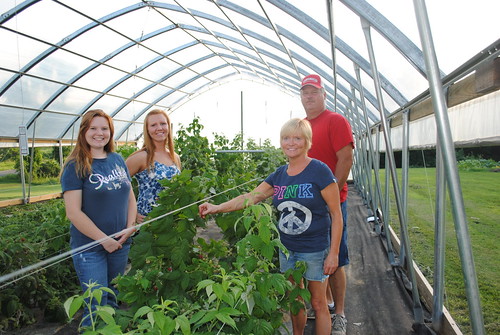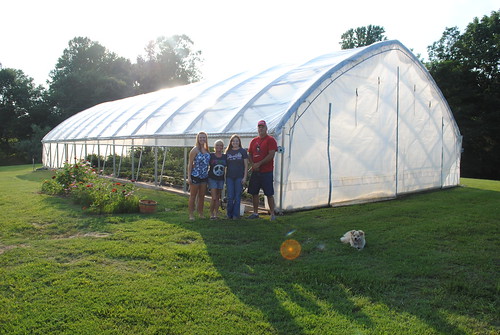
Similar to the old adage, when Chris Adams married the wife, he married the family – and the family farm. Lucky for him, he loves farming and enjoys working with his in-laws to manage the 4,000-acre farm of soybeans, wheat and corn. Now it’s his full-time job, working with his brother-in-law to raise fields of commodity crops each year. But recently, Chris and Tracy Adams, and the rest of the family, began experimenting with farming at a much smaller scale.
They built a seasonal high tunnel, a greenhouse-like structure that produces a plentiful supply of strawberries, raspberries, tomatoes and peppers. High tunnels are made of plastic or metal pipe and covered with sheeting, typically made of plastic. Unlike greenhouses, they require no energy to heat, instead relying on natural sunlight to create favorable conditions for growing vegetables and other specialty crops.
USDA’s Natural Resources Conservation Service offers technical and financial assistance for landowners, like the Adams family, to build seasonal high tunnels.
Sandra Voils, Adams’ mother-in-law, serves on the Russell County Soil and Water Conservation District board of supervisors, so she first told her family about high tunnels and how they could benefit from one. Chris and Tracy Adams did extensive research on strawberries and raspberries and decided they would focus on these fruits for the high tunnel’s first year.

The Adams family, with NRCS’ help, also installed drip irrigation and planted a row of wildflowers next to the high tunnel to attract pollinators to help the plants in the garden to flourish. The drip irrigation allows them to apply water at the base of plants, ensuring water is used wisely.
Local buyers who have heard about the delicious berries give their phone number to Tracy, asking her to let them know when they’re ready. “I like my produce fresh, and we pick the day we sell them, that way the berries are at the freshest possible condition,“ she said.
Thanks to the seasonal high tunnel, her new morning staple has become Greek yogurt with fresh raspberries. “It is rewarding to go pick your breakfast fresh,” she said. “It is a great way to start the day.”

